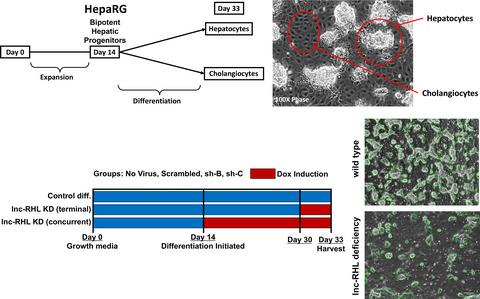当前位置:
X-MOL 学术
›
Cell Prolif.
›
论文详情
Our official English website, www.x-mol.net, welcomes your
feedback! (Note: you will need to create a separate account there.)
lnc‐RHL, a novel long non‐coding RNA required for the differentiation of hepatocytes from human bipotent progenitor cells
Cell Proliferation ( IF 5.9 ) Pub Date : 2021-01-04 , DOI: 10.1111/cpr.12978 Bindu Prabhakar 1 , Soowan Lee 1 , Adara Bochanis 1 , Wu He 2 , José E Manautou 1 , Theodore P Rasmussen 1, 3, 4
Cell Proliferation ( IF 5.9 ) Pub Date : 2021-01-04 , DOI: 10.1111/cpr.12978 Bindu Prabhakar 1 , Soowan Lee 1 , Adara Bochanis 1 , Wu He 2 , José E Manautou 1 , Theodore P Rasmussen 1, 3, 4
Affiliation

|
OBJECTIVES
The final stage of liver development is the production of hepatocytes and cholangiocytes (biliary epithelial cells) from bipotent hepatic progenitor cells. We used HepaRG cells, which are bipotent and able to differentiate into both hepatocytes and cholangiocytes, as a model to study the action of a novel lncRNA (lnc-RHL) and its role in the regulation of bipotency leading to hepatocytes and cholangiocytes. MATERIALS AND METHODS
Differentiation of HepaRG cells was assessed by marker expression and morphology which revealed their ability to differentiate into hepatocytes and cholangiocytes (modelling the behaviour of hepatoblasts in vivo). Using a qRT-PCR and RACE, we cloned a novel lncRNA (lnc-RHL; regulator of hepatic lineages) that is upregulated upon HepaRG differentiation. Using inducible knockdown of lnc-RHL concurrently with differentiation, we show that lnc-RHL is required for proper HepaRG cell differentiation resulting in diminution of the hepatocyte lineage. RESULTS
Here, we report the discovery of lnc-RHL, a spliced and polyadenylated 670 base lncRNA expressed from the 11q23.3 apolipoprotein gene cluster. lnc-RHL expression is confined to hepatic lineages and is upregulated when bipotent HepaRG cells are caused to differentiate. HepaRG cells made deficient for lnc-RHL have reduced ability to differentiate into hepatocytes, but retain their ability to differentiate into cholangiocytes. CONCLUSIONS
Deficiency for lnc-RHL in HepaRG cells converts them from bipotent progenitor cells to unipotent progenitor cells with impaired ability to yield hepatocytes. We conclude that lnc-RHL is a key regulator of bipotency in HepaRG cells.
中文翻译:

lnc-RHL,一种新型长非编码RNA,是从人双能祖细胞分化肝细胞所需的
目的 肝脏发育的最后阶段是从双能肝祖细胞产生肝细胞和胆管细胞(胆管上皮细胞)。我们使用具有双能性且能够分化为肝细胞和胆管细胞的 HepaRG 细胞作为模型来研究新型 lncRNA (lnc-RHL) 的作用及其在调节肝细胞和胆管细胞双能性中的作用。材料和方法 通过标记表达和形态来评估 HepaRG 细胞的分化,这揭示了它们分化为肝细胞和胆管细胞的能力(模拟体内成肝细胞的行为)。使用 qRT-PCR 和 RACE,我们克隆了一种新型 lncRNA(lnc-RHL;肝谱系调节因子),该 RNA 在 HepaRG 分化时上调。在分化的同时使用 lnc-RHL 的诱导型敲低,我们发现 lnc-RHL 是适当的 HepaRG 细胞分化所必需的,从而导致肝细胞谱系的减少。结果在这里,我们报告了lnc-RHL的发现,这是一种从11q23.3载脂蛋白基因簇表达的剪接和聚腺苷酸化的670碱基lncRNA。 lnc-RHL 表达仅限于肝谱系,当双能 HepaRG 细胞分化时,lnc-RHL 表达上调。 lnc-RHL缺陷的HepaRG细胞分化为肝细胞的能力降低,但保留了分化为胆管细胞的能力。结论 HepaRG 细胞中 lnc-RHL 缺陷会将其从双能祖细胞转化为单能祖细胞,且产生肝细胞的能力受损。我们得出结论,lnc-RHL 是 HepaRG 细胞双能性的关键调节因子。
更新日期:2021-01-04
中文翻译:

lnc-RHL,一种新型长非编码RNA,是从人双能祖细胞分化肝细胞所需的
目的 肝脏发育的最后阶段是从双能肝祖细胞产生肝细胞和胆管细胞(胆管上皮细胞)。我们使用具有双能性且能够分化为肝细胞和胆管细胞的 HepaRG 细胞作为模型来研究新型 lncRNA (lnc-RHL) 的作用及其在调节肝细胞和胆管细胞双能性中的作用。材料和方法 通过标记表达和形态来评估 HepaRG 细胞的分化,这揭示了它们分化为肝细胞和胆管细胞的能力(模拟体内成肝细胞的行为)。使用 qRT-PCR 和 RACE,我们克隆了一种新型 lncRNA(lnc-RHL;肝谱系调节因子),该 RNA 在 HepaRG 分化时上调。在分化的同时使用 lnc-RHL 的诱导型敲低,我们发现 lnc-RHL 是适当的 HepaRG 细胞分化所必需的,从而导致肝细胞谱系的减少。结果在这里,我们报告了lnc-RHL的发现,这是一种从11q23.3载脂蛋白基因簇表达的剪接和聚腺苷酸化的670碱基lncRNA。 lnc-RHL 表达仅限于肝谱系,当双能 HepaRG 细胞分化时,lnc-RHL 表达上调。 lnc-RHL缺陷的HepaRG细胞分化为肝细胞的能力降低,但保留了分化为胆管细胞的能力。结论 HepaRG 细胞中 lnc-RHL 缺陷会将其从双能祖细胞转化为单能祖细胞,且产生肝细胞的能力受损。我们得出结论,lnc-RHL 是 HepaRG 细胞双能性的关键调节因子。











































 京公网安备 11010802027423号
京公网安备 11010802027423号